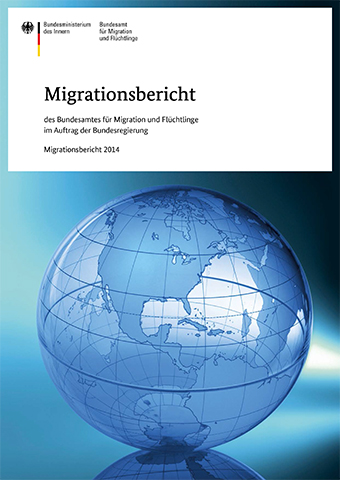The 2014 Migration Report ,

The 2014 Migration Report, which was drawn up by the Federal Office for Migration and Refugees, was presented by Federal Interior Minister Dr. Thomas de Maizière on 6 January 2016. In addition to comprehensive data on migration regarding Germany, the Report contains a European comparison on migration-related events and on asylum-related immigration. It addresses the phenomenon of irregular migration and provides information on the structure and development of the population with a migration background.
Major results
- 2014 witnessed the highest level of immigration and the highest net migration since 1992.
- Immigration increased by 19 percent year-on-year in 2014. The number of those moving away rose by 15 percent; the migration surplus is 550,000 persons. The number of immigrants must be expected to rise markedly once more in 2015 as a result of the considerable asylum-related immigration.
- Internal EU migration accounts for 55 percent of total immigration to Germany. Although the absolute number of Union citizens immigrating to Germany has continued to increase, the share of internal EU migration among total immigration is falling because of the disproportionate increase in asylum-related immigration.
- The year-on-year increase in the number of asylum applicants continued as a result of the increase in the number of trouble spots in the world (+60 percent to 203,000 applicants). The indicators of irregular migration also forecast a rise in this context.
- Immigration gained considerably greater momentum in 2015 too, in particular as a result of the marked rise in the number of people seeking asylum. The first eleven months of 2015 saw the number of asylum applicants (425,000 persons) rise by 134 percent vis-à-vis the same period in the previous year. The number of asylum-seekers registered in the “EASY” system in the same period was much higher (965,000 persons).
- Immigration by specialist workers from countries outside the European Union rose by 13 percent year-on-year in 2014.
- 93,000 young people who had obtained their higher education entrance qualification abroad commenced studies in Germany, this being more than ever before.
- Poland remained immigrants’ main country of origin, as has been the case since 1996.
- Immigration from Romania and Bulgaria rose continually since EU accession in 2007.
- The numbers of immigrants from Croatia have also increased considerably since the country acceded to the EU as per 1 July 2013.
- One in five of Germany’s inhabitants has a migration background, this figure being as many as roughly one-third among children aged under ten.
The Federal Government's Migration Report is published on an annual basis by the Federal Office for Migration and Refugees.
The Migration Report is only available in German.

